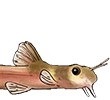New Brachyplatystoma
- Silurus
- Posts: 12420
- Joined: 31 Dec 2002, 11:35
- I've donated: $12.00!
- My articles: 55
- My images: 893
- My catfish: 1
- My cats species list: 90 (i:1, k:0)
- Spotted: 424
- Location 1: Singapore
- Location 2: Moderator Emeritus
New Brachyplatystoma
Lundberg, JG & A Akama, 2005. Brachyplatystoma capapretum: a New Species of Goliath Catfish from the Amazon Basin, with a Reclassification of Allied Catfishes (Siluriformes: Pimelodidae). Copeia, 2005: 492â??516.
Abstract
Brachyplatystoma capapretum n. sp., a pimelodid catfish from the Amazon River, is described and diagnosed by its fine, densely spaced outer jaw teeth and relatively few rows of straight, depressible inner teeth; juveniles with large dark blotches on and above lateral line; adults with exceptionally dark pigmentation dorsally, abruptly countershaded near lateral line; broad, shallowly forked caudal fin. The systematic position of the new species was investigated with a maximum parsimony phylogenetic analysis of morphological characters. The resulting cladograms identify a nested set of unambiguous characters supporting the following monophyletic groups and taxonomic recommendations. Brachyplatystomatini new tribe is established for Brachyplatystoma and Platynematichthys and supported by two synapormorphies: two-chambered gas bladder connected by paired lateral tubes; cleithrum with blade-like ventral crest between pectoral spine articulation and posterior process of cleithrum. The monotypic genera Goslinia and Merodontotus are placed in synonymy with Brachyplatystoma characterized here by two synapomorphies: suspensorium greatly expanded mediodorsally, forming a massive plate approaching parasphenoid; juveniles with greatly elongated caudal-fin filaments developed from single outermost, unbranched principal rays. Bleeker's genus group name Malacobagrus is employed as a subgenus within Brachyplatystoma to include B. filamentosum, B. capapretum, and B. rousseauxii. Monophyly of Malacobagrus is supported by five synapomorphies: adults developing extensive reticulated system of lateralis tubules on body; Weberian complex with thick, ventral bony platform at gas bladder attachment; subquadrangular shape of opercle; pectoral spine with sulcus along anterior edge; small, non-sutured endopterygoid. Two unique synapomorphies place B. capapretum and B. filamentosum together as sister species: juveniles with spots on and above lateral line; caudal peduncle subcircular in cross-section.
Abstract
Brachyplatystoma capapretum n. sp., a pimelodid catfish from the Amazon River, is described and diagnosed by its fine, densely spaced outer jaw teeth and relatively few rows of straight, depressible inner teeth; juveniles with large dark blotches on and above lateral line; adults with exceptionally dark pigmentation dorsally, abruptly countershaded near lateral line; broad, shallowly forked caudal fin. The systematic position of the new species was investigated with a maximum parsimony phylogenetic analysis of morphological characters. The resulting cladograms identify a nested set of unambiguous characters supporting the following monophyletic groups and taxonomic recommendations. Brachyplatystomatini new tribe is established for Brachyplatystoma and Platynematichthys and supported by two synapormorphies: two-chambered gas bladder connected by paired lateral tubes; cleithrum with blade-like ventral crest between pectoral spine articulation and posterior process of cleithrum. The monotypic genera Goslinia and Merodontotus are placed in synonymy with Brachyplatystoma characterized here by two synapomorphies: suspensorium greatly expanded mediodorsally, forming a massive plate approaching parasphenoid; juveniles with greatly elongated caudal-fin filaments developed from single outermost, unbranched principal rays. Bleeker's genus group name Malacobagrus is employed as a subgenus within Brachyplatystoma to include B. filamentosum, B. capapretum, and B. rousseauxii. Monophyly of Malacobagrus is supported by five synapomorphies: adults developing extensive reticulated system of lateralis tubules on body; Weberian complex with thick, ventral bony platform at gas bladder attachment; subquadrangular shape of opercle; pectoral spine with sulcus along anterior edge; small, non-sutured endopterygoid. Two unique synapomorphies place B. capapretum and B. filamentosum together as sister species: juveniles with spots on and above lateral line; caudal peduncle subcircular in cross-section.

- Silurus
- Posts: 12420
- Joined: 31 Dec 2002, 11:35
- I've donated: $12.00!
- My articles: 55
- My images: 893
- My catfish: 1
- My cats species list: 90 (i:1, k:0)
- Spotted: 424
- Location 1: Singapore
- Location 2: Moderator Emeritus
- Jools
- Expert
- Posts: 16148
- Joined: 30 Dec 2002, 15:25
- My articles: 198
- My images: 948
- My catfish: 237
- My cats species list: 87 (i:237, k:1)
- My BLogs: 7 (i:10, p:202)
- My Wishlist: 23
- Spotted: 450
- Location 1: Middle Earth,
- Location 2: Scotland
- Interests: All things aquatic, Sci-Fi, photography and travel. Oh, and beer.
- Contact:
One wonders if this is the new species? It does appear " abruptly countershaded near lateral line" but I'm not sure about the "broad, shallowly forked" caudal.

Jools

Jools
Owner, AquaticRepublic.com, PlanetCatfish.com & ZebraPleco.com. Please consider donating towards this site's running costs.
- Silurus
- Posts: 12420
- Joined: 31 Dec 2002, 11:35
- I've donated: $12.00!
- My articles: 55
- My images: 893
- My catfish: 1
- My cats species list: 90 (i:1, k:0)
- Spotted: 424
- Location 1: Singapore
- Location 2: Moderator Emeritus




